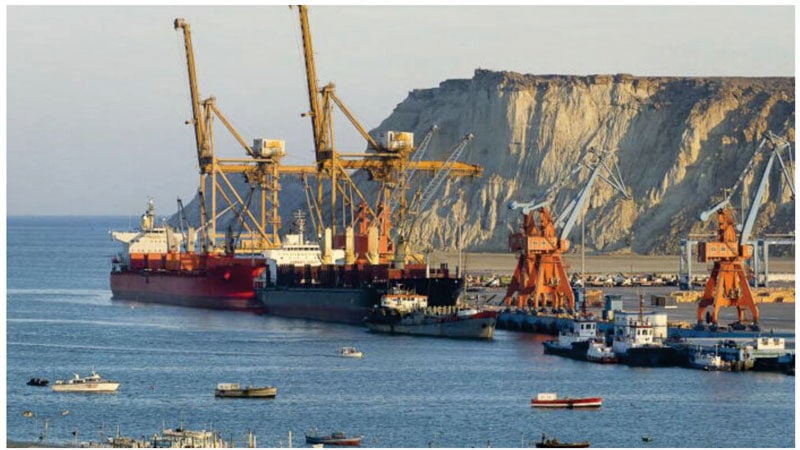GWADAR, once a modest fishing village along Pakistan’s south-western coast, has evolved into a critical focal point for international trade. With nearly 1,000 miles of coastline, 770 of which belong to Balochistan, Pakistan enjoys a unique geographical advantage. Yet, despite its location and immense potential, Gwadar Port remains underutilized, waiting for the opportunity to play its part in shaping Pakistan’s economic future. The strategic vision of the China-Pakistan Economic Corridor (CPEC) has transformed Gwadar from a sleepy coastal town into a significant hub with the promise of becoming a key player in global trade and strategic affairs.
The government of Pakistan has recently recognized the need to fully activate Gwadar Port. The other day, the federal cabinet took a crucial step by approving a policy that mandates all government entities to route 50% of their imports, including wheat, sugar, and fertilizers, through Gwadar. This decision is aimed at easing the burden on Karachi Port and taking advantage of Gwadar’s underutilized capacity. Furthermore, the cabinet directed that the volume of exports from Gwadar should also be increased in the future. To ensure the success of this policy, a subcommittee was formed to present quarterly reports to the cabinet on the progress of imports and exports through Gwadar. These steps indicate a serious commitment by the government to finally bring Gwadar into full operation, not just as a port but as an economic engine for the country.
Gwadar’s journey is a remarkable one. The city was originally part of Oman until 1958, when former Prime Minister Malik Feroz Khan Noon negotiated its purchase and incorporated it into Pakistan. For many years, Gwadar remained a quiet town with an economy centred on fishing, offering little indication of the transformative role it would eventually play. However, its deep-sea capabilities made it a prime candidate for a large-scale port, one that could support not only Pakistan’s trade needs but also those of the wider region. The development of Gwadar under CPEC has made it a focal point not only for trade but also for strategic and military interests. The port has the potential to serve as a key transit point for energy supplies, particularly oil and gas shipments from the Middle East to China, offering a more direct and cost-effective route.
As Gwadar becomes more operational, the economic benefits for Pakistan and, specifically, Balochistan are undeniable. One of the most significant impacts of a fully functional Gwadar Port will be the creation of thousands of jobs for the local population. Balochistan, one of Pakistan’s most underdeveloped provinces, has long suffered from a lack of economic opportunities. Gwadar represents a chance to change this, offering the local population access to employment, infrastructure improvement and greater involvement in trade-related activities. Additionally, the port’s operations will have a ripple effect throughout the economy, boosting industries such as logistics, transportation, and services.
At the national level, Gwadar Port promises to be a game-changer for Pakistan’s economy. Once fully operational, it will alleviate the burden on Karachi Port, which has been overworked for years. By diverting a portion of imports and exports to Gwadar, the government can ease congestion and improve the efficiency of trade operations. The port’s development will also enhance Pakistan’s export capacity, allowing the country to engage more effectively with global markets. This will be particularly important as Pakistan seeks to increase its exports and reduce its trade deficit. Gwadar, by offering a direct link to international shipping routes, can help cut down the time and cost of transporting goods, making Pakistani products more competitive on the global stage.
However, the road to fully realizing Gwadar’s potential is not without challenges. For one, there are significant infrastructural hurdles that need to be overcome. While the port itself has been developed, the surrounding infrastructure—such as roads, railways and logistical facilities—must be upgraded to support increased trade volumes. Without efficient transportation networks, goods arriving at Gwadar will face delays in reaching their final destinations, undermining the port’s potential. Moreover, the security situation in the region remains a concern, with Balochistan experiencing periodic unrest. Ensuring a stable and secure environment around the port will be crucial for attracting international investment and trade.
Another critical issue is the need to ensure that the local population benefits from Gwadar’s development. Too often, large infrastructure projects in underdeveloped regions leave local communities marginalized, with a few opportunities to share in the economic gains. In the case of Gwadar, the government must prioritize the needs of the people of Balochistan. This means not only providing jobs but also investing in education and skills development so that locals are equipped to take on the opportunities created by the port. Furthermore, the government must address the longstanding grievances of the Baloch people, many of whom feel excluded from national development projects. Without addressing these concerns, it will be difficult to ensure long-term stability in the region.
Gwadar represents the future of Pakistan’s economy. As a strategic port with the potential to become a global trade hub, Gwadar offers Pakistan an unparalleled opportunity to reshape its economic landscape. However, this potential will only be realized if the government takes decisive action to fully activate the port and ensure that its benefits are shared with all Pakistanis, especially the people of Balochistan. The recent government policy mandating the use of Gwadar for 50% of government imports is a step in the right direction, but much more remains to be done.
Pakistan must seize this moment to unlock Gwadar’s full potential. With the right infrastructure, policies, and security measures in place, Gwadar can become the engine of Pakistan’s economic growth, reducing reliance on Karachi Port and enhancing the country’s trade capabilities. The economic gains from a fully operational Gwadar will be felt not only in Balochistan but throughout the nation, providing a much-needed boost to Pakistan’s economic development. The future of Gwadar is bright, but it requires continued investment, careful planning, and a commitment to ensuring that the port’s development benefits all of Pakistan’s citizens.










